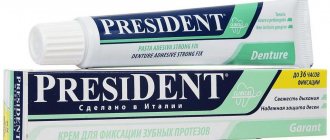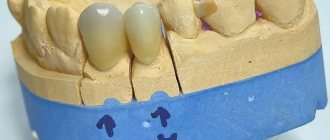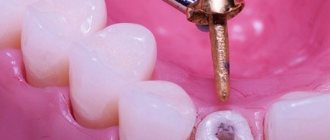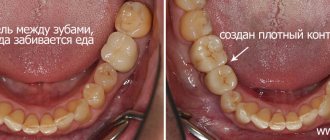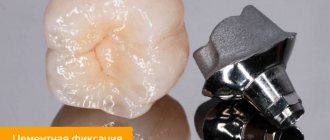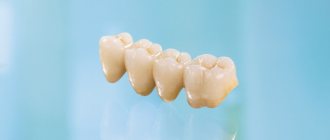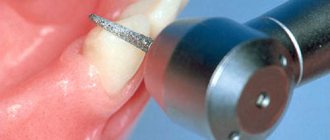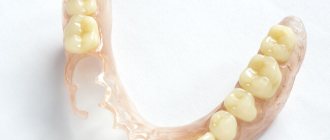- Service life of different types of crowns
- Late crown replacement
- When to change a crown
- How to change crowns
- How often are crowns replaced?
- Additional videos
Sooner or later, most people have to deal with dental prosthetics.
Perhaps the most common type of prosthetics is the so-called “dental crown” (more information about different crowns here). Many patients are their owners, but only a few patients ask questions: do dental crowns need to be replaced, how often should dental crowns be changed, etc.
Let's try to figure it out.
What is the service life of different types of crowns?
As you know, any structure has a certain service life. Unnecessarily long use can lead to dire consequences.
So: how often should crowns be replaced?
It is believed that the average service life of a crown is 5-7 years. At one time, scientists proved that it is after such a period of time that the cement on which the crown is fixed begins to undergo changes. But this does not mean that the crown must be changed every 5 or 7 years. During this period, a doctor should evaluate it to understand whether it can still serve or whether the crown needs to be replaced.
In addition to the duration of use, during a preventive examination, the doctor evaluates the following parameters: the quality of the marginal fit of the crown to the tooth, the condition of the gums and bone tissue next to the crown, X-ray data of the tooth, patient complaints, etc.
Pros and cons of prosthetics
Spray-coated metal crowns are quite popular today. More often than others, people over 50 years of age decide to install them. Among their advantages:
- service life more than ten to fifteen years;
- resistance to increased loads;
- affordable cost (they cost much less than the well-known metal ceramics);
- fast production;
- easy installation;
- resistance to erosion;
- high strength (chips and cracks do not appear on the surface);
- hygiene (fit as closely as possible to the gums, which eliminates the proliferation of pathogens and the occurrence of inflammatory diseases of the mucous membranes of the oral cavity).
Of course, they also have disadvantages. This refers to the lack of aesthetics for prosthetics in the smile area (you can choose more beautiful substitutes) and the need for mandatory preparation.
What determines the service life of a crown?
- The service life and the need to replace the structure greatly depend on the accuracy of manufacturing at all stages. Precision work means that the crown fits to the tooth without gaps, without steps, without voids, oral fluid and food do not get under it, the gums around it do not become inflamed, it is no different from the “native” tooth. It is the precision of manufacturing that determines the quality of work, and therefore is the key to a long service life of the crown. For example, I had to deal with a situation where the crown was made only a year ago, and upon examination, strict indications for its urgent replacement were revealed (due to poor quality, namely inaccurate manufacturing). And vice versa, when examined, the crown meets all the requirements, all parameters are normal, there is no need to replace it, and it has been standing for 10 years (which means it was manufactured very accurately and in a timely manner).
- We have repeatedly mentioned that accuracy, and therefore quality, is at the forefront. If we take quality as a given, then the material and method of fixation come to the fore. So, the service life also depends on the material from which the crown is made and, accordingly, on the method of fixing it to the tooth . Classic metal-ceramics and zirconium dioxide-based crowns are attached to a special “cement,” that is, an intermediary between the crown and the tooth, and do not enter into a “chemical” bond with either this cement or the ground tooth. Namely, this cement is “destroyed” and “washed out” over time, leading to a violation of the seal of the entire structure. Crowns based on lithium disilicate (also called “E-max”) are fixed without an intermediary: using the adhesive (“glue”) method, that is, they are glued to the tooth tissue, which leads to a very strong connection between the crown and the tooth. Accordingly, the service life of such structures is longer than the 5-7 years described above, which means that a crown change will not be required soon.
- In addition, the service life is greatly influenced by the condition of the tooth for which the crown was made. If a patient hesitates for a long time to adequately restore a damaged tooth, he comes for prosthetics at an untimely rate, in particular when the tooth is destroyed by a carious process to the level or below the level of the gum, becoming “soft” and unreliable. In such conditions, the doctor is no longer able to make an accurate marginal fit; such a structure will never be completely sealed, which means the tooth under such a crown will be destroyed. In such conditions, neither good materials nor the method of fixing the crown will help. And if the doctor nevertheless undertakes the restoration of such a tooth, this will be the last crown on it, since it will be impossible to repeat the restoration.
Important! Dear patients, do not delay the restoration of damaged teeth, do not deprive yourself of the opportunity to save your own tooth faster, more reliably and cheaper!
By clicking on the “Make an appointment” button, I consent to the processing of my personal data.
I have read and agree with the conditions for processing personal data set out on the website ds-chocolate.ru.
Consent to the processing of personal data
What are the consequences of untimely crown replacement?
1. Destruction of the tooth under the crown with its subsequent loss.
The main function of a crown is to restore a badly damaged tooth and protect it. The first time after installation, the crown performs its function perfectly. But after a certain time, changes occur. The gingival margin rises, saliva and gingival fluid affect the cement that “secures” the crown. Over time, this cement can be partially washed out (dissolved), a microscopic gap is formed between the crown and the tooth, and the tooth begins to deteriorate under the influence of microbes and oral fluid. The most insidious thing is that these signs occur asymptomatically and unnoticed by the patient, since they are painless. Therefore, replacement of crowns often occurs untimely, when the tooth is destroyed too much and becomes simply unreliable.
Associated with this is the myth that teeth under crowns are destroyed. The truth is that crowns are simply replaced at the wrong time, but too late.
This can be prevented by timely replacement of the orthopedic structure.
2. Inflammation of the tissues around the crown . This means the gums, tooth ligament and bone tissue. A poor-quality crown can lead to the formation of a chronic inflammatory process in the gums (gingivitis, periodontitis), which is manifested by redness, bleeding when brushing teeth, aching pain in the gums and an unpleasant odor. If such a crown is not replaced for a long time, the underlying tissues become involved in the inflammatory process, which may lead to the formation of bone pockets, disruption of the ligamentous apparatus of the tooth, and local periodontitis, which in severe cases leads to tooth loss.
Photo 2.1. Inflammation of the gums near teeth under crowns, associated with inaccurate marginal fit of the crown to the tooth and with a violation of the biological parameters of tooth restoration.
Important! Make it a rule to visit the dentist for a preventive examination at least once a year, if you have any dentures, in order to notice their failure in time and prevent or correct the problem.
Indications and contraindications for installation
Metal appliances are usually made when missing molars need to be restored. They cope well with high chewing loads and last a very long time.
Their installation is also indicated in the following situations:
- in order to prevent further abrasion of damaged units;
- to increase the reliability of fixation of removable dentures;
- to recreate the natural shape of a partially destroyed natural crown;
- in the absence of one/several teeth;
- if it is necessary to replace worn-out dental devices that were manufactured several years ago.
They can also be considered as supporting units if a dental bridge is planned for the upper or lower jaw.
As for contraindications, the list is not very long:
- cancer diseases;
- bruxism;
- malocclusion, subject to mandatory preliminary correction;
- increased abrasion of units of the opposite jaw;
- severe periodontal disease, periodontitis;
- osteoporosis, osteomyelitis of the bone tissue of the jaws.
How do you know if it’s time to change the crown or if it can still serve?
There are objective signs that reflect the condition of crowns/bridges, which are assessed by an orthopedic dentist during a routine examination:
- service life of the crown/prosthesis
- patient complaints (pain, food getting stuck near the crown, unpleasant odor near the crown, and others)
- fit of the crown to the tooth (marginal fit)
- the presence of areas of plaque accumulation
- condition of the gums next to the crown (color, bleeding, density, presence of other signs of inflammation, raising the edge of the gums (exposure of the root))
- presence of signs of inflammation of the bone tissue around the tooth with a crown
- density of interdental contact (crowns with adjacent teeth).
If one or a number of signs are present, the doctor decides whether the crown needs to be replaced.
Structural features
Any coated metal crown is a one-piece construction. Previously, they were produced according to a standard sample, and then the doctor had to “adjust” the system to the characteristics of the patient’s oral cavity. Of course, this was difficult to do. Today the situation is different - all prostheses are made exclusively from individual casts, so little or no time is spent on adjustments.
The main advantage of metal systems is the variety of choices. Taking into account his financial capabilities and personal wishes, a person can order the production of units with lining, with or without coating. If you need to make a dental bridge, then the artificial teeth are not soldered together, but the system is immediately made in the form of a single, aesthetic row. This completely eliminates the presence of interdental spaces in which food accumulates.
Can the patient himself understand that it is time to replace the crown?
Certainly! There are a number of signs, the presence of which should give cause for concern.
- The most common is crown edge exposure , when the gingival margin rises and the tooth root becomes visible (“gingival recession”). In this case, root caries may develop, that is, the tooth may be destroyed.
Photo 2.2. The initial stage of exposure of the roots of the teeth under the crowns.
Photo 2.3. The advanced stage of exposure of the roots of the teeth under the crowns.
- Inflammation of the gums around the crown , which manifests itself in redness of the gums, swelling, and bleeding when brushing.
Photo 2.4. Inflammation of the gingival margin of teeth under crowns, associated with inaccurate marginal fit of the crown to the tooth and with a violation of the biological parameters of tooth restoration.
- The appearance of crown mobility . Patients often say that the crown or bridge is “fixed.” This happens especially often when several crowns are combined (some of the crowns of the bridge have become uncemented, while the rest are still holding together).
- The appearance of an unpleasant odor or taste in the crown area.
- Food getting stuck between crown/crown and tooth.
Important! All of the above signs are a mandatory reason to visit the dentist.
Materials for dentures:
- Zirconium dioxide is the most durable of materials. Withstands up to 20 years of use without changing its characteristics. Does not respond to sudden temperature changes. It also does not cause intolerance and is absolutely safe.
- Aluminum oxide is almost as good in appearance as zirconium and other ceramic structures and has a natural white color. At the same time, it is less durable and less resistant to abrasion or impact, so it is rarely used to restore chewing teeth. In some cases, an allergic reaction to aluminum may occur.
- Porcelain - in terms of aesthetics, this is the most preferred type of material. It is also absolutely harmless in terms of allergic reactions. However, despite its strength, it is also the most fragile. Porcelain can withstand pressure, but impacts can damage it. Therefore, it is also almost never used on chewing teeth.
- Usually it is used for prosthetics of incisors or canines.
Such prostheses require careful handling, but if precautions are taken, they last up to 15 years.
The main disadvantages are:
- Increased risk of chipping
- High price for all varieties.
How are crowns replaced?
A separate article will be devoted to this. Let us briefly describe the main stages:
Stage 1 : examination by a doctor and diagnosis (X-rays). We evaluate the accuracy of the crown fit, the condition of the tooth and surrounding tissues. We understand that the crown needs to be replaced.
2nd stage : silicone key (necessary for the doctor to make you a temporary crown so that you do not go without a tooth after removing the old one)
Stage 3 : we evaluate the tooth under the crown, give it the correct shape, clean it, and remove possible caries. We fix the temporary crown. You can't go a day without a tooth!
Stage 4 : we take impressions for the new crown and send them to the dental laboratory.
Stage 5 : we get a new crown, fix it on the tooth and happily say goodbye to the doctor until the next professional examination.
Bottom line: how long does it take to replace crowns?
According to the book rules : in 5-7 years.
It is better to replace poorly made crowns immediately after placement, so that the teeth underneath do not deteriorate.
Well-made crowns can last 10 years or more.
Conclusion: any crown has a certain service life, which depends on the characteristics of the clinical situation (tooth condition), quality of workmanship, material and method of fixation. The need for replacement is determined by the doctor based on a number of objective factors. Timely replacement allows you to reuse the same foundation (tooth, root) to repeat the structure. Accordingly, the tooth will last for many years. Untimely replacement of the crown (unreasonably long use) can lead to deep tooth destruction, which will be impossible to restore.
An attentive attitude to one’s health on the part of the patient, coupled with timely and qualified assistance from a doctor, leads to a long-term positive result.
By clicking on the “Make an appointment” button, I consent to the processing of my personal data.
I have read and agree with the conditions for processing personal data set out on the website ds-chocolate.ru.
Consent to the processing of personal data
Be healthy!
